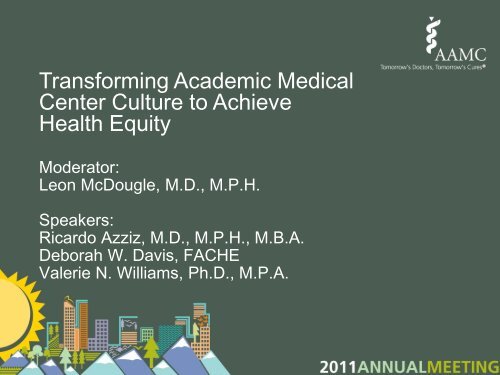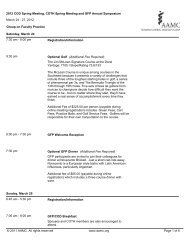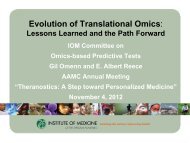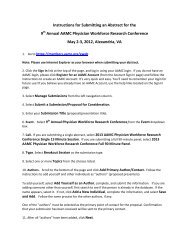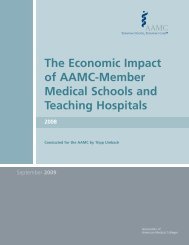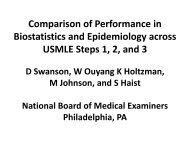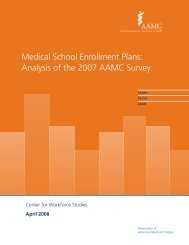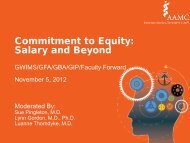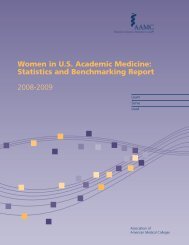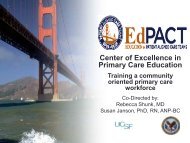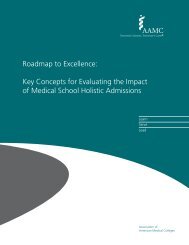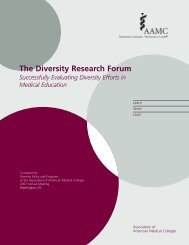Transforming Academic Medical Center Culture to Achieve Health ...
Transforming Academic Medical Center Culture to Achieve Health ...
Transforming Academic Medical Center Culture to Achieve Health ...
- No tags were found...
Create successful ePaper yourself
Turn your PDF publications into a flip-book with our unique Google optimized e-Paper software.
<strong>Transforming</strong> <strong>Academic</strong> <strong>Medical</strong><strong>Center</strong> <strong>Culture</strong> <strong>to</strong> <strong>Achieve</strong><strong>Health</strong> EquityModera<strong>to</strong>r:Leon McDougle, M.D., M.P.H.Speakers:Ricardo Azziz, M.D., M.P.H., M.B.A.Deborah W. Davis, FACHEValerie N. Williams, Ph.D., M.P.A.
Group on Diversity and InclusionMissionMission and FocusThe GDI is a national forum and recognized resource <strong>to</strong> support AAMC members intheir efforts <strong>to</strong> realize the benefits of diversity and inclusion in medicine andbiomedical sciences across all parts of their institutions and the communityFocusMembershipContactDiversity and inclusion in faculty, graduate medical education, and professionaldevelopment/institutional climate• Designated GDI RepresentativeU.S. medical school dean designates a faculty or administra<strong>to</strong>r who hasresponsibility for institutional multicultural/diversity affairs• Individual GDI RepresentativesOpen membership, U.S. medical school dean or self-designatedJuan Amador, Direc<strong>to</strong>r and GDI Program Leader202.862.6149jamador@aamc.orgwww.aamc.org/gdi
GDI DefinitionsDiversity, Inclusion, and <strong>Health</strong> EquityDiversity as a core value embodies inclusiveness, mutual respect, and multipleperspectives and serves as a catalyst for change resulting in health equity. In thiscontext, we are mindful of all aspects of human differences such as socioeconomicstatus, race, ethnicity, language, nationality, sex, gender identity, sexual orientation,religion, geography, disability and ageInclusion is a core element for successfully achieving diversity. Inclusion is achievedby nurturing the climate and culture of the institution through professional development,education, policy, and practice. The objective is creating a climate that fostersbelonging, respect, and value for all and encourages engagement and connectionthroughout the institution and community<strong>Health</strong> Equity is when everyone has the opportunity <strong>to</strong> attain their full health potentialand no one is disadvantaged from achieving this potential because of their socialposition or other socially determined circumstance (Source: CDC)
GDI National PrioritiesDiversity and Inclusion in FacultyShort TermPriority 1Priority 2Identify GDI data needs and define a comprehensivedata setIntegrate issues unique <strong>to</strong> underrepresented groupsin medicine and biomedical sciences (UGMBS)faculty in<strong>to</strong> the Group on Faculty Affairs (GFA) NewMember ToolkitDiversity and Inclusion in Graduate <strong>Medical</strong> Education (GME)Short TermLong TermDevelop a GDI <strong>to</strong>olkit on underrepresented groups inmedicine and biomedical sciences (UGMBS) faculty forour academic institutionsDevelop an academic medicine pipeline/activities forunderrepresented groups in medicine and biomedicalsciences (UGMBS) <strong>to</strong> enhance the diversity in our facultyworkforceLong TermPriority 1 Develop Holistic Review for residency admissions Develop an academic medicine pipeline forunderrepresented groups in medicine and biomedicalsciences (UGMBS) residents in collaboration with otherAAMC Professional Development GroupsDiversity and Inclusion in Professional Development/Institutional ClimateShort TermPriority 1Priority 2Priority 3Provide professional development in collaborationwith other AAMC Professional Development GroupsAdding Lesbian, Gay, Bisexual, Transgender (LGBT)issues and concerns <strong>to</strong> national agenda at all levelsPresent GDI’s definition of diversity and inclusion <strong>to</strong>all AAMC memberships, organizations, and senioradministrationLong TermDevelop a GDI Orientation Guide for the GDI SteeringCommittee and GDI membersContinuous campaign <strong>to</strong> empower and engage GDImembership
What Do Leaders Do?•Provide vision•Interpret the environment•Empower & create teams•Engage communities•Model behavior•Lead and manage change7
What is Different in aTransformative vs. a ChangingEnvironment?Transformation implies a greater degreeof change from what has been the normTransformation is necessary when:• The external environment is changing rapidly andaggressively, or…• The institution needs <strong>to</strong> go far <strong>to</strong> meet the curren<strong>to</strong>r future environmental challenges• Or… more often, both8
Why is GHSU on a TransformativePath?Rapidly and aggressively changing external forces:• Sharply declining state support• Increasing competition locally and from other USG institutions• Radically changing healthcare environment• Increasing focus on discovery, and declining ability <strong>to</strong> supportresearch efforts through clinical pass-through $• Increasing mobility of work force• Radically changing speed ofcommunication• Increasing global pressures andknowledge competition• Marked economic recession9
Why is GHSU on a TransformativePath?… And GHSU is less prepared <strong>to</strong> face theseenvironmental threats because so far it has beenrelatively well insulated and protected:• Relatively high level of state support• Primary focus on education with captive student population• Steady incremental growth• Limited competition within USG• Clinical operations focused onlocal market• Static employee population• Relatively resilient local economy• Little demand for more robust ROI10
Transformative LeadershipTransformative leadership is thetype of leadership requiredduring radically shifting times orsituations <strong>to</strong> achievetransformation, not just simplychange, of an enterprise11
Transformative LeadershipTransformative leadership requires differentemphases, strategies, or skills than leadership inless radical or shifting situationsBecause:• Direction <strong>to</strong> be taken varies significantly fromcurrent course• Prior institutional experience with change is limited• The rapidity of the pace is critical• Prevailing leadership culture and internal expertisemay be unprepared or unsupportive• Risk of failure is higher12
Seven Critical TransformativeLeadership Skills1. The capacity <strong>to</strong> envision and formulate theworkings of a new world2. The willingness <strong>to</strong> personally and directlyengage3. An ability <strong>to</strong> sense and drive pace4. A great need <strong>to</strong> recognize excellence5. A readiness <strong>to</strong> address issues personally6. The skill <strong>to</strong> build bridges7. The willingness <strong>to</strong> accept extremeambiguity and uncertainty13
1– Capacity <strong>to</strong> Envision theWorkings of a New WorldThe ability <strong>to</strong> envision and build radically newstructures and their workings should be:• Guided by ultimate function and objective, ratherthan by ownership, credit, or authority• Focused on the intangibles that form the core andessence of the missionFormulating a working transformativevision requires borrowing fromexperiences beyond our training14
Effecting Change – Where Should We Be?The importance of setting the vision firstThere!!ThereHereHere“If you do notknow where youare going, everyroad will get younowhere”Henry Kissinger15
2 – Willingness <strong>to</strong> Personally &Directly Engage:Selling the VisionA transformative vision should be:• Compelling, exciting, and inclusive• Should highlight the path and workings…Willing <strong>to</strong> engage in vigorous dialogue,vetting disparate and opposing viewsIf you aren’t selling, then nobody is buying!!16
3 – Ability <strong>to</strong> Sense & Drive PaceUnderstand that pace matters… and thatwindows of opportunity don’t stay openlong…Become adept at measuring progress <strong>to</strong>stay on course and on timeRespect your competi<strong>to</strong>rs… they help <strong>to</strong>set your paceComprehend that one must start ‘Now’17
4 – The Need <strong>to</strong> RecognizeExcellenceTo lead <strong>to</strong> excellence you must recognize andknow excellenceAlways assume that you are competing with the‘Best in Class’… so find out what the best doDo not just expect and reach for excellence inyour own niche… drive excellenceIf “Good enough Is good enough”… thenmaybe it’s not really neededSeek & recruit excellence… and invest in people18
5 – Readiness <strong>to</strong> Address IssuesPersonallyNormally, good leadership principles (and leaders’survival) imply that:• Team members and designees are empowered• Much of the work… and <strong>to</strong>ugh actions… will be carried out bydelegatesHowever, in a transformative environment few in the teammay be prepared <strong>to</strong> act… which…Requires that transformative leaders be willing andproactive in addressing issues directly & personally…Along with leadership development/recruitment19
6 – The Skill <strong>to</strong> Build BridgesBridges are two-way streets….Bridges are bidirectional… but not necessarilybuilt <strong>to</strong> equal extents…Before building a bridge, the grounds shouldbe ready… on both sides…Bridges have <strong>to</strong> be built <strong>to</strong> last…outliving those that created them…Bridges have <strong>to</strong> be built using manydifferent approaches…20
6 – The Skill <strong>to</strong> Build BridgesBuilding bridges does not obviate the need forindividual accountability and responsibility…When building bridges expect set-backs…AND accept them as proof that the bridge needs<strong>to</strong> be built…Building bridges is about the rightleadership…21
7 – Willingness <strong>to</strong> Accept ExtremeAmbiguity & Uncertainty:THE ART OF SCULPTING IN CLAYUnderstand and communicate thefact that building new futures isan iterative process, rooted inambiguity and uncertaintyIf all the signals were clear andthe path well defined thenleaders would not be needed22
Transformative Leadership isRiskyThe risk of failure is greater due <strong>to</strong>:• Significant institutional inertia• Limited knowledge of the situation on ground• Limited leadership support• The need <strong>to</strong> highlight a vision and path early• The need <strong>to</strong> leverage crises• Degree of personal time/energy requiredGreater speed → greater risk of error“Change Agent” labelThe conundrum of the ‘elected politician’So ‘Transformative Leadership’ strategies should/canonly be used for a limited time23
Transformation at GHSU•Operationalized <strong>Health</strong> System – 6 mos.•Changed names of enterprise – 6 mos.•Reorganized leadership structure – 4 <strong>to</strong>12 mos.•Integrated all major leadership functions – 12 mos.•Recruited 75% of leadership – 24 mos.•Implemented a Variable Pay/Salary-at-Risk Plan for all leaders – 12 mos.•Completed short-term strategic assessment (ESP) – 4 mos.•Initiated enterprise-wide LTSP (Transformation 2020) – 6 mos.•Presented 8-year vision for Governor/Chancellor – 15 mos.•Resolved litigation & established multiple Foundation model – 8 mos.•Created Board of Visi<strong>to</strong>rs – 14 mos.•Implemented an electronic process for T&E and eIRB – 12 mos.•Initiated Quality initiative in HS – 4 mos.•Initiated Service Line structure in HS – 18 mos.•Addressed budget shortfall/integration savings with RIF – 15 mos.24
Dwight D. Eisenhower(1890 –1969)The one qualitythat can develop bystudious reflectionand practice is theleadership of men25
TransformativeLeadershipThank you26
Innovations inCommunity <strong>Health</strong>:How an <strong>Academic</strong> <strong>Medical</strong> <strong>Center</strong> isLeading the WayDeborah W. Davis, FACHEChief Operating Officer<strong>Medical</strong> College of Virginia Hospitals -Virginia Commonwealth University <strong>Health</strong> SystemNovember 5, 2011
VCU <strong>Health</strong> System Overview• VCU <strong>Health</strong> System - the clinical delivery componen<strong>to</strong>f the VCU <strong>Medical</strong> <strong>Center</strong>• Only academic medical center in Central Virginia• Referral center for the state and Mid-Atlantic• 33,500+ admissions and 550,000+ outpatient visits• 84,000 emergency department visits• MCV Hospitals• Teaching hospital of the VCU <strong>Health</strong> System• 805 licensed beds• 20.5% share of the Richmond inpatient market• The region's only Level-I Trauma <strong>Center</strong>• Children’s Hospital of Richmond• Pediatric specialty hospital• 60 licensed pediatric long term care beds• MCV Physicians• 560-physician, faculty group practice• Major funding source VCU School of Medicine• Virginia Premier <strong>Health</strong> Plan• 150,000 member Medicaid <strong>Health</strong> Plan• University <strong>Health</strong> Services, Inc.
VCUHS Source of Patients by Payer55,698 Adj. Discharges for Twelve Months Ending June 30, 2011Actual Governmental Payers/Self Pay is 75.3% of Total
Improving Community <strong>Health</strong> for“At Risk” PopulationsVCUHS is leading the way with several innovativeapproaches:• Virginia Coordinated Care (VCC) for theUninsured• Virginia Premier <strong>Health</strong> Plan• Office of <strong>Health</strong> Innovation• Population Management• Primary Care Initiative
Virginia Coordinated Care (VCC)for the Uninsured• Established in the Fall of 2000• Goal is <strong>to</strong> coordinate health care services for asubset of the patients who qualify for theCommonwealth’s Indigent Care program• Target population is uninsured patients below200% FPL in the Greater Richmond and Tri-Cities areas
VCUHS Partnerships Lead <strong>to</strong> VCCVirginia GeneralAssembly passesSJR179 <strong>to</strong> analyzeprimary care capacityCity <strong>Health</strong> DeptAnd VCUHSpartner <strong>to</strong> createSouth Richmond<strong>Health</strong> <strong>Center</strong> (SRHC)<strong>Health</strong> Departmentturns overmanagement ofthe SRHCTo VCUHSVCUHSlaunches theCity Care programThe VCCprogram isestablished inpartnershipwithcommunityPCP’s19911992 1994 1998 1999 2000 2011Richmond UrbanPrimary Care Initiative(RUPCI) determinesthere is a need forprimary care inSouth RichmondSRHC is renamedHayes Willis <strong>Health</strong><strong>Center</strong>for VCU physicianCommunity andVCUHSreps examine thefeasibilityof expanding CityCare <strong>to</strong>Uninsured adultsIntro of thePMI modelfor <strong>Health</strong>Care Reform
VCC Outcomes• Enrollment in FY11 was over 30,000 patients• 50 providers participated from Community-basedPhysician practices and Safety Net providers• VCUHS has invested over $32 million <strong>to</strong> support theprovision of care in community settings• VCC program has resulted in reduced costs andutilization of services• Reductions were observed from 2001 <strong>to</strong> 2003 in the proportions ofenrollees with inpatient hospitalizations (17.6% vs 13.8%) and withemergency department visits (73.9% vs 42.9%) *• VCUHS is transitioning the VCC program in<strong>to</strong> apopulation health management program* Retchin SM, Garland SL, Anum EA. The transfer of uninsured patients from academic <strong>to</strong>community primary care settings. Am J Manag Care. 2009 Apr;15(4):245-52.
Virginia Premier <strong>Health</strong> Plan• Virginia Premier <strong>Health</strong> Plan is a non-profit managed careorganization partnered with VCU <strong>Health</strong> System• Mission: To meet the needs of underserved and vulnerablepopulations in Virginia by delivering quality driven, culturallysensitive, and financially viable healthcare• Purchased by VCUHS in 1998 with roughly 14,000Medicaid members• VPHP now enrolls over 150,000 Medicaid members acrossVirginia
VA Premier’s Support for the VCUHSVirginia Premier endeavors <strong>to</strong> support the multiple missionsof the VCU <strong>Health</strong> System through:• Financial contributions: Since 2004, Virginia Premier has madedonations and offered grants <strong>to</strong> the VCU <strong>Health</strong> System in excess of$22 Million.• Shared Administrative Costs: Virginia Premier absorbedapproximately $5 Million in administrative costs in FY11 that wouldotherwise be allocated <strong>to</strong> other business units within the VCU <strong>Health</strong>System. Total shared administrative costs through FY 11 is over $25Million.• Operational Support: Virginia Premier assists the VirginiaCoordinated Care (VCC) program through provision of Third PartyAdministrative services (Claims payment <strong>to</strong> community physicians,member services, and other administrative services).
VA Premier Accomplishments• The Top Ranked <strong>Health</strong> Plan in Virginia for four consecutive years -2008, 2009, 2010, 2011• In 2011 Virginia Premier <strong>Health</strong> Plan (VPHP) is ranked 26 th Nationally out ofover 200 Medicaid <strong>Health</strong> Plans• Through VPHP’s nationally recognized <strong>Health</strong>y Heartbeats Prenatal program,we have decreased the number of preterm and low-birth weight babies• 2010 Best Practice Award for Anti-Depressant Medication Management -Awarded by Virginia Department of <strong>Medical</strong> Assistance Services (DMAS)• The <strong>Center</strong> for <strong>Health</strong> Care Strategies awarded DMAS and VPHP theInnovation Award for Improving <strong>Health</strong> Care Quality for Racially andEthnically Diverse Populations• 2008-VPHP was awarded the “Recognizing Innovation in Multicultural <strong>Health</strong>Care Award” by the National Committee of Quality Assurance (NCQA)• Virginia Premier is the only Virginia health plan that operates its owntransportation system, inclusive of vans that will be utilizing alternative fuels(Compressed Natural Gas / Propane fueled vehicles)• VPHP Awarded NCQA Accreditation Status – Top Rating “Excellent”
VCU Office of <strong>Health</strong> Innovation• Establishes an operational unit <strong>to</strong> develop businessopportunities <strong>to</strong> address the goals of the medical center• Collaboration between VCU and VCUHS housed in the VCUSchool of Medicine• Focus will be on the development of initiatives <strong>to</strong> prepare forhealth reform• Innovation strategies will be developed through researchinitiatives, demonstration projects, and educationalopportunities• Partnerships will be critical <strong>to</strong> success of the VCU Office of<strong>Health</strong> Innovation• Relationships are being built with entities across Virginia including thestage agencies, professional societies, local health departments,community-based agencies, etc.
What the Office of <strong>Health</strong> Innovation willAccomplish• Identification of federal grants and demonstration projects that alignwith interests of the VCU <strong>Health</strong> System and VCU faculty• Development of population management strategies (e.g., ACO’s,<strong>Medical</strong> Homes, etc.)• Service delivery models• Payment reform models• Predictive modeling for populations• Expansion of community engagement activities <strong>to</strong> include:• Translational research initiatives• Development of education and training models• Partnerships with community-based organizations• Collaborations with state agencies• Participation in initiatives with national organizations• Creation of patient education initiatives
Population Management Initiative (PMI)• The Population Management Initiative (PMI) will focuson the VCC patients that are generating the most costs
Expected Outcome:An Accountable System of Care• Episodic population (Level 1) – 61% of the population Navigation support <strong>to</strong> clinical and social services Chronic illness screening Explore Urgent care options• Chronic/Stable population (Level 2) – 15% of the population Strengthen medical homes Improve communications between VCUHS and medical homes Implement value-based reimbursement model• High risk/high cost patients (Level 3) – 6% of the population Establish Interdisciplinary team model Embed intensive case management in the “medical home” Improve patient “hand-offs”
VCU Primary Care Initiative (PCI)The VCUHS primary care initiative (PCI) includes twostrategies:1. Provide consultative assistance and support <strong>to</strong> smallpractices and Federally Qualified <strong>Health</strong> <strong>Center</strong>s (FQHC)<strong>to</strong> implement the patient centered medical home(PCMH) model• Develop a program in Central Virginia• Focus on underserved populations2. Expand the number of primary care and dentalresidency programs in medically underserved areas• Focus on sites that are adopting components of thePCMH model
Formula for Primary Care Initiative• Conduct a “Readiness” Assessment of Primary Care Practices• Provide Consultative and Support Services for Practices• Practice management support• <strong>Health</strong> Information Technology• Case Management/Care Coordination• Data/Analytics• Physician Payment• Evaluation• Work with Practices <strong>to</strong> identify Sustainability Options, including:• <strong>Achieve</strong>ment of “Meaningful Use” standards• Practice efficiencies that enhance attractiveness <strong>to</strong> payers interested in alternativepayment models• Review health reform demonstration grants <strong>to</strong> identify fundingopportunities <strong>to</strong> establish primary care and dental residencies inexisting FQHC’s
Expected Outcomes of PCI• Improved efficiency at small practices and FQHCs <strong>to</strong>ensure long-term sustainability• Expanded access <strong>to</strong> primary care and dental servicesfor “at-risk” populations• Larger healthcare workforce for the Commonwealth ofVirginia, especially in medically underserved areas• Development of a primary care blueprint that istransformative and transferable <strong>to</strong> other areas ofVirginia and beyond
Why is it important for AMCs <strong>to</strong> leadefforts <strong>to</strong> improve community health?• AMCs have resources and expertise <strong>to</strong> assist communityproviders and local/state governments with themanagement of “at risk” populations• Leverage robust analytical and informatics capabilities• Through training programs, AMCs are well positioned <strong>to</strong>introduce a new paradigm of health delivery <strong>to</strong> the futurehealthcare workforce• AMCs are the nation’s “Safety Net” and have unmatchedexperience caring for the most vulnerable populations
“University-based urbanacademic medical centers….function mosteffectively and for the greater goodwhen their care is a complement <strong>to</strong>,and not a substitute for,community health care providers.”Hill, Laurence and Madara, James, “Role of the Urban <strong>Academic</strong> <strong>Medical</strong> <strong>Center</strong> in US <strong>Health</strong> Care”,Journal of the American <strong>Medical</strong> Association, November 2, 2005 – Vol 294, No. 17, p.2219.
AcknowledgementsTo request more information on programs at VCUHS, please contact:Sheryl GarlandVice President, <strong>Health</strong> Policy and Community RelationsVCU <strong>Health</strong> SystemPhone: (804) 828-1290Email: sgarland@mcvh-vcu.eduMichael VasellAnalystVCU <strong>Health</strong> SystemPhone: (804) 628-2083Email: mvasell@mcvh-vcu.edu
Leadership Development<strong>Transforming</strong> <strong>Academic</strong> <strong>Medical</strong> <strong>Center</strong><strong>Culture</strong> <strong>to</strong> <strong>Achieve</strong> <strong>Health</strong> EquityValerie N. Williams, Ph.D., M.P.A.Vice Provost for <strong>Academic</strong> Affairs & Faculty DevelopmentUniversity of Oklahoma <strong>Health</strong> Sciences <strong>Center</strong>November 5, 2011
Diversity as a core value embodies inclusiveness, mutual respect,and multiple perspectives and serves as a catalyst for change resultingin health equity. In this context, we are mindful of all aspects of humandifferences such as socioeconomic status, race, ethnicity, language,nationality, sex, gender identity, sexual orientation, religion, geography,disability and age.Inclusion is a core element for successfully achieving diversity.Inclusion is achieved by nurturing the climate and culture of theinstitution through professional development, education, policy, andpractice. The objective is creating a climate that fosters belonging,respect, and value for all and encourages engagement and connectionthroughout the institution and community.AAMC Group on Diversity and Inclusion
The mission of theUniversity ofOklahomais <strong>to</strong> provide the bestpossible educationalexperience for ourstudents throughexcellence in teaching,research and creativeactivity, and service <strong>to</strong>the state and society.
University of Oklahoma <strong>Health</strong>Sciences <strong>Center</strong> MissionEducate students at the professional,graduate, and undergraduate levels <strong>to</strong>become highly qualified health servicespractitioners, educa<strong>to</strong>rs, and researchscientists;Conduct research and creative activities forthe advancement of knowledge throughteaching and development of skills; andProvide continuing education, public service,and clinical care of exemplary quality.
OUHSC Provost and ExecutiveDean Andrews’ Vision“The University of Oklahoma <strong>Health</strong> Sciences<strong>Center</strong> will be the premier enterprise foradvancing healthcare, medical and healthprofessions education, biomedical research andpublic outreach for the community, state andregion.Through our combined efforts, we strive <strong>to</strong>improve the lives of all people.”Emphasis added
Faculty (Full-time Fall 2010)Allied <strong>Health</strong> 57Dentistry 48Medicine 765OKC (661)Tulsa (104)Nursing 84Pharmacy 70Public <strong>Health</strong> 42Graduate College 27FacultyTotal = 1,093
Students (Fall 2011)Allied <strong>Health</strong> 641Provost Andrews’ SnapshotPharmacy 476Dentistry 337 Public <strong>Health</strong> 259Medicine 1,035 Plus Graduate CollegePlus over 600 physicians inresidency and fellowship trainingin 60 specialties orsubspecialtiesNursing 835StudentTotal = 3,624
Diversity and Inclusion byLeadership Development: ThreeExamples and Lessons LearnedThe <strong>Center</strong> for Learning and Leadership/ Oklahoma’s UCEDDThe NARCH Faculty Development ProjectThe OUHSC Faculty Leadership Program
Disability in Perspective for Oklahoma2009 Oklahoma Population ComparisonsOklahomans with disabilities 565,619Oklahomans (age 5 and up) whohave cognitive difficulties 206,578Some comparative figures___________________________________Oklahoma City population 551,754City of Tulsa population 386,622School enrollment grades K-12 653,585Oklahomans age 65 and over 473,565Civilian veterans 313,711Source: Oklahoma Department of Rehabilitation Services. http://www.okrehab.org/info/OK_statistics.htm
His<strong>to</strong>ry - <strong>Center</strong> for Learning andLeadership/UCEDD• UCEDD founded 1992• Vision: create accepting,respectful, accessiblecommunity for all Oklahomans• Federally designated center forexcellence with specificresponsibilities• “Core business”: education,systems change, policy/research• OUHSC UCEDD collaborateswith in-state <strong>Academic</strong> Partnersand national network of 67state/terri<strong>to</strong>ry programs• 42 member Consumer AdvisoryCommittee (CAC)• CAC Co-Chaired by a communitymember and the program direc<strong>to</strong>r• CAC members include faculty,staff, private providers, publicagency personnel and peoplewith developmental disabilitiesand family members of PWDD• Sibling orgs in Oklahoma:Redlands Partners - theOklahoma DevelopmentalDisabilities Council and theOklahoma Disability Law <strong>Center</strong>
<strong>Center</strong> for Learning andLeadership/UCEDD• “A SecondOpinion”• FamilyFaculty• PartnershipValues
Influences on CulturalCompetence ExpectationsSocial Paradigm “Alpha”Social Paradigm “A”• Hierarchy• Exclusive• Assimilate• Give and Take Orders• Control• Compete• Community• Inclusive/participation• Value diversity• Build consensus• Shared power/team work• CollaborateOur goal: Create a learning and leadership paradigmAdapted from Emerging values for a diverse workplace, J.Leach, 1995
NARCH Faculty Development
What is CulturalCompetence?“Cultural competency” implies an awareness ofhealth beliefs and behaviors, disease preventionand incidence, and treatment outcomes fordifferent populations.[i] It is, however, important <strong>to</strong>note that we have much <strong>to</strong> learn about how <strong>to</strong>operationalize cultural competency.”Source: [i] Risa Lavizzo-Mourey and Elizabeth R. Mackenzie, “CulturalCompetence: Essential Measurements of Quality for Managed CareOrganizations,” Annals of Internal Medicine, 124 (May 15, 1996), 919-21.
NARCH Faculty DevelopmentPartnership“Within our group, I probably had the least clinicalresearch experience. The NARCH researchlearning collaborative enabled me <strong>to</strong> beginresearch that I wanted <strong>to</strong> participate in and have awealth of research experience at my fingertips.Learning the CBPR process and now feeling like a“go <strong>to</strong>” researcher in my tribal community ispriceless.”--Tom K. MD
Cultural Competence as a skill for researchprofessionals might be measured by:Ability <strong>to</strong> design and conduct research in waysthat are acceptable and useful <strong>to</strong> the personparticipating in the research as a subject orcommunity stakeholder because it iscongruent with their cultural background andexpectations.NARCH created a research learning community <strong>to</strong>build our competence <strong>to</strong>gether.
Building Capacity for CulturalCompetenceThe National <strong>Center</strong> for Cultural Competence(George<strong>to</strong>wn Univ) embraces a conceptual framework anddefinition of cultural competence that requiresorganizations <strong>to</strong> have the capacity <strong>to</strong>:(1) value diversity,(2) conduct self-assessment,(3) manage the dynamics of difference,(4) institutionalize cultural knowledge, and(5) adapt <strong>to</strong> diversity and the cultural contexts of thecommunities they serve.
The OUHSC Faculty Leadership Program• 1990: Decision <strong>to</strong> upgrade intentional men<strong>to</strong>ring forearly- and mid-career faculty. Created OUHSCFaculty Leadership Program. Core based on work byC. Bland et al.• 1990 early career longitudinal faculty developmentinaugurated. Faculty eligible post 1 year on board.• 1990 <strong>to</strong> 2003 had 24-month pgm; 2-days per• 2004 <strong>to</strong> present have 11-month pgm; ~1-day per• Accepted class downsized from 25 <strong>to</strong> 16 per year• Since inception 363 early career faculty havecompleted. All OUHSC colleges participate.
OU-FLP Program OverviewSelf Management Mission Skills Peer Feedback Leadership SkillsIndividual FacultyDevelopment Plan(IFDP) Fall – goalsettingInstructional strategiesFLP Faculty FellowOrientation, groundrules and expectationsStrategic Overview andGoal AlignmentGoal AlignmentMeeting w/ Dept ChairLearner assessmentTeaching & TestQuestion Writingsimulation and peerfeedbackSkills for working withthe MediaTime Management(professional & Prsnl)Framing Research andScholarshipPeer-Men<strong>to</strong>r meetingsNegotiation AdvancedsimulationIndividual FacultyDevelopment Plan(IFDP) Spring – postannual reviewPreparing the academicadvancement CV anddossierPresenting Your Work1: Feedback items, setup,delivery, Q&A,acknowledgement,wrap and transitionLeadership Retreatpersonality , teamwork& organization culture;leadership cases, legalissues/ case studyTemperament &PersonalityPresenting significanceof Scholarship-in-Progress (Abstractprep)Presenting Your Work2: Refinements andtimingGraduation Remarks byFLP Faculty FellowsNegotiation Basics
FLP Puts Leadership in ContextAdministrationTeachingServiceResearch &Scholarship
FLP Puts Leadership in ContextCare of self & spiritAdministrationTeachingCare of loved onesServiceResearch &ScholarshipCare of homeand community
Early Career Faculty ReportedResults – Skill ImprovementDuring the past year <strong>to</strong> what degreehave your skills improved?Clear orSignificantImprovement(%)Understanding & using leadership principles 91.7Understanding & using teamwork principles 91.7Providing peer feedback <strong>to</strong> colleagues 91.7Requesting focused feedback from senior 91.7colleaguesPreparing for/taking on a leadership role 91.7Summative Bi-Annual 2010 and 2011 cohorts. n = 22; RR 88%
Lessons LearnedThe <strong>Center</strong> for Learning and Leadership/Oklahoma’s UCEDDThe NARCH Faculty Development ProjectThe OUHSC Faculty Leadership Program
AcknowledgementsOUHSC Senior Vice President andProvost• M. Dewayne Andrews, MD, MACP<strong>Center</strong> for Learning andLeadership/UCEDD• J. Devereaux, Consumer AdvisoryCommittee Co-Chair• M. Wolraich, MD. CAC Vice Chair• V. Martin, MA, UCEDD Associate Direc<strong>to</strong>rNARCH IV Principal Investiga<strong>to</strong>r• T. Cooper, M.D., Chickasaw NationNARCH Project Advisory Committee• S. Goodson, Chickasaw Nation• S. Khan, Cherokee Nation• B. Lance, Chickasaw Nation• L. Stephens, OUHSC• J. Tomasek, OUHSCOUHSC Faculty Leadership Program• L. Fentem, Associate Direc<strong>to</strong>rFLP Program Faculty & Men<strong>to</strong>rs• M. Medina, EdD• D. DiGiacin<strong>to</strong>, MS• X. Ding, PhD• M. Fisher, RN• D. Frimberger• C. Garcia, MD• K. Sorocco, Ph.D.• D. Thompson, PhD• S. Vesely, PhDThe 363 FLP Program Graduates <strong>to</strong> date
Questions?
Save the DateGFA/GDIProfessional Development ConferenceAugust 9-12, 2012Indianapolis, IndianaGroup on Faculty AffairsGroup on Diversity and InclusionProfessional Development Conference


